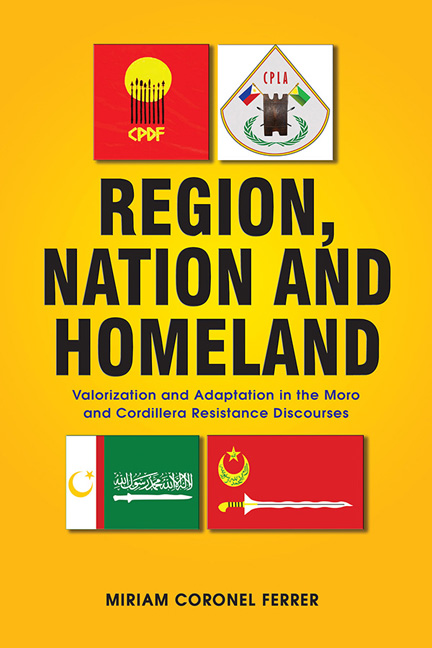 Region, Nation and Homeland
Region, Nation and Homeland Book contents
- Frontmatter
- Contents
- Preface
- List of Abbreviations
- Maps
- 1 Introduction: Text and Resistance
- 2 The Moro Liberation Movement: From Secession to Autonomy
- 3 The Cordillera Movement (1970s–2008): Building and Losing the Consensus
- 4 Nation, Homeland and Ancestral Domain: Intertextuality in the Moro Discourse
- 5 Identity Ambivalence in the Pan-Cordillera Discourse
- 6 Conclusion
- Bibliography
- Index
- About the Author
3 - The Cordillera Movement (1970s–2008): Building and Losing the Consensus
Published online by Cambridge University Press: 02 April 2020
- Frontmatter
- Contents
- Preface
- List of Abbreviations
- Maps
- 1 Introduction: Text and Resistance
- 2 The Moro Liberation Movement: From Secession to Autonomy
- 3 The Cordillera Movement (1970s–2008): Building and Losing the Consensus
- 4 Nation, Homeland and Ancestral Domain: Intertextuality in the Moro Discourse
- 5 Identity Ambivalence in the Pan-Cordillera Discourse
- 6 Conclusion
- Bibliography
- Index
- About the Author
Summary
“To claim a place is the birthright of every man.… For us indigenous peoples, ancestral land is literally life, our continued survival as viable communities and distinct cultures with our brand of indigenous ethnic identities.”
— Macli-ing DulagUnlike in Mindanao, where the Moro population was overtaken by the influx of migrants from Luzon and the Visayas, the indigenous populations in the Cordillera remained the dominant populations in the region. Mining operations and government-led projects did lead to land-use conversion and changes in ownership in the more economically developed areas, but there was no massive resettlement of migrant populations. Relative deprivation and underdevelopment, a common context of many ethnopolitical mobilizations, are present within the region and vis-à-vis the national capital region. But several Cordillera provinces fare better in terms of income and other human development indicators than other provinces in the country. The region as a whole is better off than several other Philippine regions, especially Muslim Mindanao. The process of political and cultural differentiation also differed. Earlier initiatives of zealous Spanish friars from the Ilocos provinces failed. One Bontoc anthropologist wrote that “Christianity was established by the Spaniards on Igorot soil” only in 1893 when the first baptism was performed, but this event was allegedly never repeated under Spanish rule. But unlike in Muslim Mindanao, American Protestant and European Catholic missionaries made inroads in the region in the early twentieth century. They established churches and schools and generated conversions among the natives to Christianity.
Although control of the entire territory was uneven, the American colonial regime succeeded in ‘pacifying’ and incorporating the northern mountainous region under their rule, a feat unaccomplished by the Spaniards. Finin cited several reasons for the relative absence of resistance against the American administrators. One is what he described as the paternalistic and exoticized treatment that the Americans accorded the natives. They gave the Igorots — the collective name used by colonial officialdom for the natives in the region — a privileged status that was not extended to lowlanders in Baguio. Cultural performances and traditional feasts like the cañao were encouraged and supported. The American regime kept their hands off the rice fields and paid wages to the locals who were hired in the public works. Although the Philippine Constabulary remained the main tool of the state for subjugating resistance, local mediators were sought to settle conflicts and other forms of pressure were applied.
- Type
- Chapter
- Information
- Region, Nation and HomelandValorization and Adaptation in the Moro and Cordillera Resistance Discourses, pp. 57 - 96Publisher: ISEAS–Yusof Ishak InstitutePrint publication year: 2020


